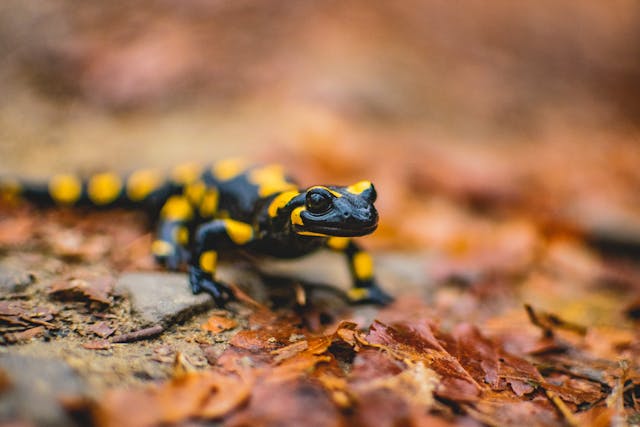
How can a salamander regenerate? They can repurpose skin cells to become any other kind of cell, similar to a stem cell.
There are many different types of salamander, about 760, but they all share several common traits. They are all amphibians, which means they are comfortable both in and out of the water. They have four legs and a long tail. They have smooth moist skin and they look a lot like lizards, although they are not lizards. The smallest salamanders are minute salamanders, which are about 27 mm long and the largest salamanders are the Chinese giant salamanders which can grow up to 1.8 m, including their tails. Like most other amphibians, they have thin skins that they can breathe through and they secrete a mucus to keep themselves moist. Some salamanders also produce strong neurotoxins. The rough-skinned newt produces the most toxic neuroprotein scientists know about and it is called tetrodotoxin. They are carnivores and eat anything they can get. They will even eat parts of each other if nothing else is available. One of the traits that all salamanders share, and the one that makes them famous, is their ability to regenerate lost limbs. How do they do it?
Scientists know how salamander are able to regrow their limbs, but they are not sure why. It seems like an ability that all animals would benefit from, but that might not be the case. Salamanders are not just limited to regrowing limbs. They are able to regenerate their tails, nerves, parts of organs, parts of their brain, parts of their spine, parts of their eyes, and other things too. Let’s look at how they go about regenerating a limb.
When a salamander loses a limb, let’s say its front right leg, a blood clot forms over the wound to stop blood loss. Once this has happened, new skin starts to grow over the wound until it is completely covered and sealed. This is the same as what would happen if we lost a limb, but our regeneration will go no further than sealing the wound. The skin we use to seal the wound would be scar tissue and that is not the same as fresh skin because it cannot grow hair or have sweat pores. Scar tissue is just the body’s attempt to close a wound as fast as possible. Salamanders don’t produce scar tissue and their regeneration keeps going. In the front leg of the salamander, every cell has a different role to play. There are bone cells, nerve cells, joint cells, skin cells, and a host of others. The only cells left at the end of the removed limb already have a fixed role, so the salamander needs to create cells that can become these other cells. To do this, signals from the wound activate nearby cells to divide and the new cells move to the site of the lost limb under the new skin. They form a mass of matter called a blastema. When the cells reach the blastema, a nerve that grows in there is able to command them to reverse their growth and they basically become stem cells, which are able to transform themselves into any other type of cell. The new cells then slowly start to rebuild the limb, layer by layer, almost like a 3D printer. It can take a few weeks for smaller and younger salamanders, or up to half a year for the bigger and older ones, but it will always regrow.
Why can’t we do the same thing? It is possible that at some point in the past, all animals could regenerate but then lost the ability. The salamanders are the only animals that kept the ability. There are several reasons for why this might be. Salamanders are able to regenerate because they have very slow metabolisms. It takes a lot of energy to regrow a limb, and salamanders can spare the energy to grow because they don’t need it for anything else. If we tried to regrow a limb, we would find it difficult to consume enough energy for the process and it would end up impacting our other bodily functions. There is also the thought that it would take us far longer to regrow a limb than a salamander and before modern medicines, losing a limb often meant death. If any of our ancestors did have the ability to regrow a limb, they would have died when they lost their limb and wouldn’t have had time to regrow it or to pass their genes on. And because of our high metabolism, our bodies have evolved to seal up wounds as quickly as they can so that we can continue with our lives. That is not to say that it wouldn’t be possible to regrow a limb or an organ. Scientists are looking at ways to activate our own cells so that they can generate an organ made of our own cells. That would make transplants much safer because our bodies wouldn’t reject them. And this is what I learned today.
Photo by Mikołaj Kołodziejczyk: https://www.pexels.com/photo/close-up-shot-of-a-fire-salamander-4102897/
Sources
https://www.science.org/content/article/how-some-salamanders-regrow-their-limbs
https://www.utmb.edu/mdnews/podcast/episode/re-growing-limbs-organs-on-horizon
https://en.wikipedia.org/wiki/Salamander
https://en.wikipedia.org/wiki/Axolotl
https://www.bbc.com/future/article/20130307-will-we-ever-regenerate-limbs
